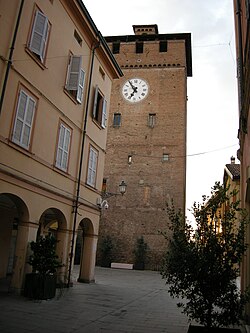Nonantola
| Nonantola | |
|---|---|
| Comune | |

Modenesi tower in town centre
|
|
| Location of Nonantola in Italy | |
| Coordinates: 44°40′41″N 11°02′32″E / 44.67806°N 11.04222°ECoordinates: 44°40′41″N 11°02′32″E / 44.67806°N 11.04222°E | |
| Country | Italy |
| Region | Emilia-Romagna |
| Province / Metropolitan city | Modena (MO) |
| Frazioni | La Grande, Casette, Campazzo, Bagazzano, Rubbiara, Redù, Via Larga |
| Government | |
| • Mayor | Pier Paolo Borsari |
| Area | |
| • Total | 55 km2 (21 sq mi) |
| Elevation | 20 m (70 ft) |
| Population (January 1, 2014) | |
| • Total | 15,773 |
| • Density | 290/km2 (740/sq mi) |
| Demonym(s) | Nonantolani |
| Time zone | CET (UTC+1) |
| • Summer (DST) | CEST (UTC+2) |
| Postal code | 41015 |
| Dialing code | 059 |
| Patron saint | St. Sylvester |
| Saint day | December 31 |
| Website | Official website |
Nonantola is a town and comune in the province of Modena in the Emilia-Romagna region of northern Italy. It is in the Po Valley about 10 kilometres (6 mi) from Modena on the road to Ferrara.
Nonantola's history is strongly connected to the Benedictine monastery. Its creation in 752 totally supplanted the old Roman colony and was the premise of Nonantola High Middle Ages importance, as it was chosen for the meeting in 883 between Pope Marinus I and the emperor Charles the Fat. Pope Hadrian III was buried here.
In the year 890 the town and the monastery were devastated by Hungarian marauders.
Nonantola was disputed between Modena and Bologna until it fell under Este's suzerainty (as an autonomous commune) in 1412. A constitution was issued in 1419. Nonantola remained a pacific agricultural centre well into the 17th century, when it had several urbanistic renovations.
In the Napoleonic Wars the abbey lost all its territories, which were acquired by the count Leonardo Salimbeni. In 1898 his palace, which once belonged to the monastery, was sold to the comune of Nonantola, becoming the Town Hall. In this age the agriculture started dying out, as the Modenese nobles used archaic methods of cultivation, and industries, trade and water were lacking.
During the German occupation in World War II the Nonantolani hosted 73 Jewish children, enabling them to flee to Switzerland. The city was awarded a Cross of War Medal for Military Valour for this feat and for its contribution to the Italian resistance movement.
Today Nonantola is an increasingly important cultural and tourist resort.
...
Wikipedia

